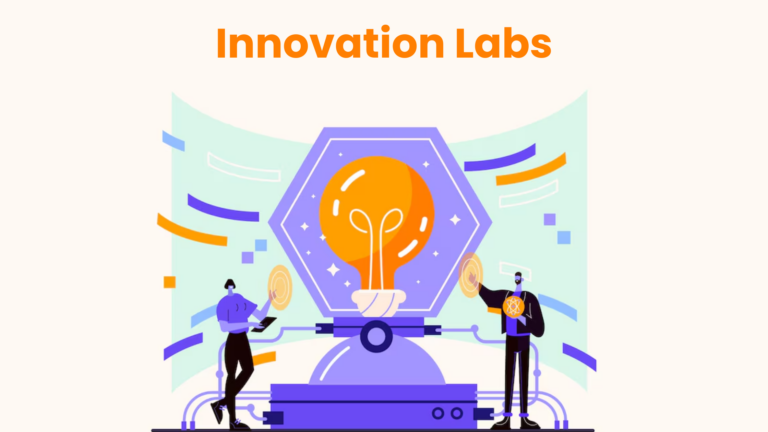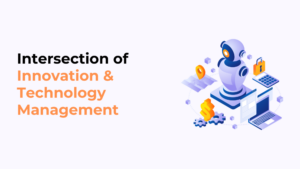90% of innovation labs fail within a few years of their launch.
The reasons why these startup-style innovation labs cannot hold ground are quite simple:
- Their inability to align with the core business
- Unclear innovation strategy to begin with
- Lack of a strong objective since most companies launch innovation labs just because everyone is
- No clear roadmap for innovation to bring ideas from conception to implementation
- A team that doesn’t understand the end customer’s needs and has no real connection with them
However, that doesn’t mean that the complete idea of having a dedicated innovation lab is pointless.
No, we do not mean to confuse you.
Let’s break it down step-by-step. First, let’s understand the innovation lab’s meaning to further identify what they mean in the current landscape and if we need one.
What is an innovation lab?
The objective of an innovation lab is to focus on innovation through experimentation and taking calculated risks.
These labs have their own dedicated physical space or unit specifically designed to foster creativity, track market trends, and develop new ideas and solutions.
These idea labs consist of colleagues in detached groups and external partners, such as startups or universities, who need constant acceptance from their employers (the organization).
Are these innovation lab ideas working today?
By the end of 2023, almost 40% of the top 200 companies had set up their own innovation labs. However, since the onset of 2024, we are seeing a different trend.
A recent article by the Wall Street Journal shows how companies are moving away from such stand-alone innovation labs. And are choosing to reintegrate their in-house incubators.
For example, Walmart shut down its technology and business innovation unit, store no. 8.
SVP and COO of Walmart, Anshu Bhardwaj, stated, “It’s very difficult for any one single team to be the subject matter expert and the tech expert at the same time.”
Another example is Ford, which closed their innovation lab in Silicon Valley, stating that its innovation efforts have evolved to be more integrated across departments within the organization.
Why is this happening?
#1 Integration Challenges
Innovation labs operate separately from the rest of the organization, which can create silos and disconnects between the innovation efforts and the company’s core business functions. This lack of integration may hinder the successful implementation of innovative ideas and solutions, leading to frustration and disillusionment with the innovation lab model.
#2 Focus on Distributed Innovation
Some companies are shifting towards a more distributed approach to innovation, where innovation efforts are decentralized and embedded within different business units or teams. This approach allows for greater alignment between innovation initiatives and strategic business objectives, as well as increased ownership and accountability at the grassroots level.
#3 Cost and ROI Concerns
Innovation labs require significant investment in terms of resources, infrastructure, and personnel. Some companies may find it challenging to justify the ongoing costs associated with running these labs, especially if they struggle to demonstrate tangible returns on investment (ROI) or if the ROI is not realized within a reasonable timeframe.
How to build an innovation lab that works for you?
You don’t have to get a separate innovation hub or incubator to get a few people to innovate for you. Period!
Instead, go inbound with these innovation labs!
As rightly put by Ed McLaughlin, the CTO of Mastercard, “There’s a mistake sometimes where organizations say innovation is something off the side rather than something that you do every day and needs to be part of every team. Innovation is like ethics. And it has to pervade the whole organization.”
Innovation isn’t a luxury; it’s a necessity. So, it’s counter-intuitive to confine it to the realm of specialized teams or reserve for designated innovation labs.
#1 The Power of Inclusive Innovation
Imagine the wealth of untapped creativity and expertise that exists within your organization – from frontline employees interacting with customers on a daily basis to back-office staff with unique perspectives on internal processes. By harnessing the collective intelligence of your entire workforce, you unlock a treasure trove of innovative ideas and solutions that can drive company growth and transformation.
But wait, there’s more.
By including every single person in your organization, regardless of their role, designation, and experience, in the innovation journey, you show them that:
- You value innovation, their ideas, perspectives, and suggestions.
- You believe in quick time-to-value.
- You support intrapreneurship and want to retain your employees
- You believe in building in-house expertise and competency.
#2 Creating a Culture of Innovation
Inclusive innovation isn’t just about soliciting ideas from every employee. It’s about fostering a culture where innovation is celebrated, encouraged, and rewarded.
You play a crucial role in setting the tone and modeling the behavior of embracing innovation at every level of the organization.
By championing a culture of experimentation, risk-taking, and continuous learning, companies create an environment where innovation thrives organically.
#3 Empowering Every Employee to Innovate
Inbound innovation lab means giving every employee the tools, resources, and support they need to contribute to the innovation process. This could involve providing training on design thinking and creative problem-solving techniques, implementing idea management platforms to capture and evaluate ideas, or establishing cross-functional innovation teams to tackle specific challenges.
An idea management platform provides a centralized platform for employees to submit their ideas, collaborate on solutions, and track the progress of innovative initiatives.
With this software, every employee has a voice in the innovation process, democratizing innovation and driving engagement across the organization.
Inclusive innovation isn’t just about generating ideas; it’s about translating those ideas into tangible outcomes that drive business results. You need to establish processes for evaluating, prioritizing, and implementing innovative ideas. And, ensure that they align with strategic objectives and deliver measurable value to the organization.
Conclusion: Making Innovation Everyone’s Business
In today’s rapidly evolving business landscape, innovation isn’t a luxury reserved for a select few – it’s everyone’s business.
By involving every employee in the process, companies can unlock the full potential of their workforce, drive growth, and stay competitive.
So, let’s break down the barriers, unleash creativity, and make innovation a part of every team every day. After all, the future belongs to those who innovate together.


